Related Research Articles

Kogarkoite is a sodium sulfate fluoride mineral with formula Na3(SO4)F. It has a pale blue color, a specific gravity of about 2.67 and a hardness of 3.5. The crystal is monoclinic and is a type of naturally occurring antiperovskite. Kogarkoite is named after the Russian petrologist Lia Nikolaevna Kogarko (born 1936) who discovered the mineral.

Melanterite is a mineral form of hydrous iron(II) sulfate: FeSO4·7H2O. It is the iron analogue of the copper sulfate chalcanthite. It alters to siderotil by loss of water. It is a secondary sulfate mineral which forms from the oxidation of primary sulfide minerals such as pyrite and marcasite in the near-surface environment. It often occurs as a post mine encrustation on old underground mine surfaces. It also occurs in coal and lignite seams exposed to humid air and as a rare sublimate phase around volcanic fumaroles. Associated minerals include pisanite, chalcanthite, epsomite, pickeringite, halotrichite and other sulfate minerals.

Thénardite is an anhydrous sodium sulfate mineral, Na2SO4 which occurs in arid evaporite environments, specifically lakes and playas. It also occurs in dry caves and old mine workings as an efflorescence and as a crusty sublimate deposit around fumaroles. It occurs in volcanic caves on Mount Etna, Italy. It was first described in 1825 for an occurrence in the Espartinas Saltworks, Ciempozuelos, Madrid, Spain and was named for the French chemist, Louis Jacques Thénard (1777–1826).
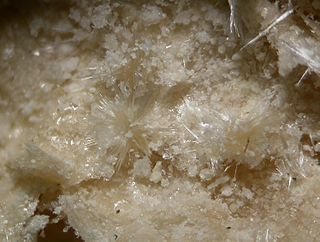
Mascagnite is a rare ammonium sulfate mineral (NH4)2SO4. It crystallizes in the orthorhombic system typically forming as stalactitic masses exhibiting good cleavage. It is soft (not higher than 2.5 on the Mohs Scale) and water-soluble. Optical properties are variable; the purest form is transparent and colorless, but opaque gray or yellow deposits are also known.

Alunogen (from French alun, “alum”), also called feather alum and hair salt is a colourless to white (although often coloured by impurities, such as iron substituting for aluminium) fibrous to needle-like aluminium sulfate mineral. It has the chemical formula Al2(SO4)3·17H2O.

Diadochite is a phospho-sulfate mineral. It is a secondary mineral formed by the weathering and hydration of other minerals. Its formula is Fe2(PO4)(SO4)OH·5H2O. Well crystallized forms are referred to as destinezite, which has been given official recognition by the International Mineralogical Association with diadochite being the poorly formed to amorphous variety.

Copiapite is a hydrated iron sulfate mineral with formula: Fe2+Fe3+4(SO4)6(OH)2·20(H2O). Copiapite can also refer to a mineral group, the copiapite group.
Wagnerite is a mineral, a combined phosphate and fluoride of iron and magnesium, with the formula (Mg,Fe2+)2PO4F. It occurs in pegmatite associated with other phosphate minerals. It is named after Franz Michael von Wagner (1768–1851), a German mining official in Munich.
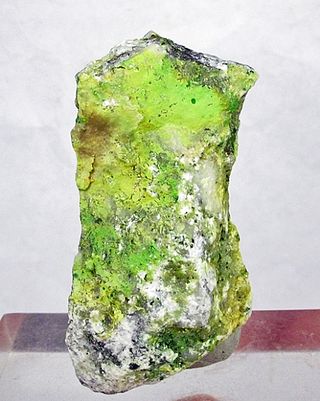
Xocomecatlite is a rare tellurate mineral with formula: Cu3(TeO4)(OH)4. It is an orthorhombic mineral which occurs as aggregates or spherules of green needlelike crystals.

Millosevichite is a rare sulfate mineral with the chemical formula Al2(SO4)3. Aluminium is often substituted by iron. It forms finely crystalline and often porous masses.

Godovikovite is a rare sulfate mineral with the chemical formula: (NH4)Al(SO4)2. Aluminium can partially be substituted by iron. Hydration of godovikovite gives the ammonium alum, tschermigite. The mineral forms cryptocrystalline, often porous, masses, usually of white colour. Single crystals are very small hexagonal blades. Typical environment for godovikovite are burning coal sites (mainly dumps). There the mineral acts, together with millosevichite, as one of the main components of so-called sulfate crust.

Rozenite is a hydrous iron sulfate mineral, Fe2+SO4•4(H2O).
Boussingaultite is a rare ammonium magnesium hydrated sulfate mineral of the chemical formula: (NH4)2Mg(SO4)2 · 6 H2O. The formula of boussingaultite is that of Tutton's salts type. It was originally described from geothermal fields in Tuscany, Italy, where it occurs together with its iron analogue mohrite, but is more commonly found on burning coal dumps. The mineral possess monoclinic symmetry and forms clear, often rounded crystals.

Devilline is a sulfate mineral with the chemical formula CaCu4(SO4)2(OH)6•3H2O. The name originates from the French chemist's name, Henri Etienne Sainte-Claire Deville (1818–1881).

Alum-(K) is a hydrous potassium aluminium sulfate mineral with formula KAl(SO4)2·12(H2O). It is the mineral form of potassium alum and is referred to as potassium alum in older sources. It is a member of the alum group.
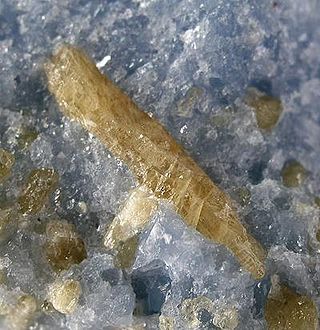
Fluorellestadite is a rare nesosilicate of calcium, with sulfate and fluorine, with the chemical formula Ca10(SiO4)3(SO4)3F2. It is a member of the apatite group, and forms a series with hydroxylellestadite.
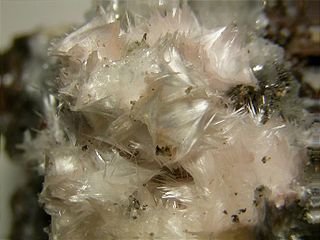
Pickeringite is a magnesium aluminium sulfate mineral with formula MgAl2(SO4)4·22(H2O). It forms a series with halotrichite.

Piypite is a rare potassium, copper sulfate mineral with formula: K2Cu2O(SO4)2. It crystallizes in the tetragonal system and occurs as needlelike crystals and masses. Individual crystals are square in cross-section and often hollow. It is emerald green to black in color with a vitreous to greasy luster.
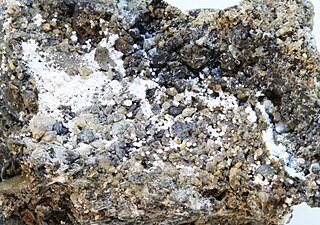
Felsőbányaite or basaluminite is a hydrated aluminium sulfate mineral with formula: Al4(SO4)(OH)10·4H2O. It is a rare white to pale yellow mineral which typically occurs as globular masses and incrustations or as minute rhombic crystals. It crystallizes in the monoclinic crystal system.
Euchlorine (KNaCu3(SO4)3O) is a rare emerald-green colored sulfate mineral found naturally occurring as a sublimate in fumaroles around volcanic eruptions. It was first discovered in fumaroles of the 1868 eruption at Mount Vesuvius in Campania, Italy by Arcangelo Scacchi. The name 'euchlorine' comes from the Greek word εΰχλωρος meaning "pale green" in reference to the mineral's color, other reported spellings include euclorina, euchlorin, and euchlorite.
References
- ↑ Warr, L.N. (2021). "IMA–CNMNC approved mineral symbols". Mineralogical Magazine. 85 (3): 291–320. Bibcode:2021MinM...85..291W. doi: 10.1180/mgm.2021.43 . S2CID 235729616.
- ↑ Efremovite, Webmineral.com
- 1 2 Efremovite, Mindat.org
- 1 2 3 Handbook of Mineralogy
- ↑ Chesnokov B. V. and Shcherbakova E. P. 1991: Mineralogiya gorelykh otvalov Chelyabinskogo ugolnogo basseina - opyt mineralogii tekhnogenesa. Nauka, Moscow
- ↑ Jambor J. L. and Grew E. S. 1991: New mineral names. American Mineralogist, 76, pp. 299-305